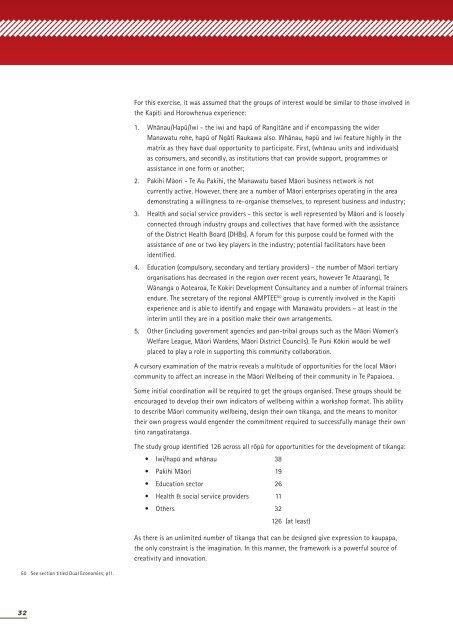He Oranga Hapori: A model for raising Maori ... - Te Puni Kokiri
He Oranga Hapori: A model for raising Maori ... - Te Puni Kokiri
He Oranga Hapori: A model for raising Maori ... - Te Puni Kokiri
- No tags were found...
You also want an ePaper? Increase the reach of your titles
YUMPU automatically turns print PDFs into web optimized ePapers that Google loves.
For this exercise, it was assumed that the groups of interest would be similar to those involved inthe Kapiti and Horowhenua experience:1. Whänau/Hapü/Iwi - the iwi and hapü of Rangitäne and if encompassing the widerManawatu rohe, hapü of Ngäti Raukawa also. Whänau, hapü and iwi feature highly in thematrix as they have dual opportunity to participate. First, (whänau units and individuals)as consumers, and secondly, as institutions that can provide support, programmes orassistance in one <strong>for</strong>m or another;2. Pakihi Mäori - <strong>Te</strong> Au Pakihi, the Manawatu based Mäori business network is notcurrently active. However, there are a number of Mäori enterprises operating in the areademonstrating a willingness to re-organise themselves, to represent business and industry;3. <strong>He</strong>alth and social service providers - this sector is well represented by Mäori and is looselyconnected through industry groups and collectives that have <strong>for</strong>med with the assistanceof the District <strong>He</strong>alth Board (DHBs). A <strong>for</strong>um <strong>for</strong> this purpose could be <strong>for</strong>med with theassistance of one or two key players in the industry; potential facilitators have beenidentified.4. Education (compulsory, secondary and tertiary providers) - the number of Mäori tertiaryorganisations has decreased in the region over recent years, however <strong>Te</strong> Ataarangi, <strong>Te</strong>Wänanga o Aotearoa, <strong>Te</strong> <strong>Kokiri</strong> Development Consultancy and a number of in<strong>for</strong>mal trainersendure. The secretary of the regional AMPTEE 50 group is currently involved in the Kapitiexperience and is able to identify and engage with Manawatu providers – at least in theinterim until they are in a position make their own arrangements.5. Other (including government agencies and pan-tribal groups such as the Mäori Women’sWelfare League, Mäori Wardens, Mäori District Councils). <strong>Te</strong> <strong>Puni</strong> Kökiri would be wellplaced to play a role in supporting this community collaboration.A cursory examination of the matrix reveals a multitude of opportunities <strong>for</strong> the local Mäoricommunity to affect an increase in the Mäori Wellbeing of their community in <strong>Te</strong> Papaioea.Some initial coordination will be required to get the groups organised. These groups should beencouraged to develop their own indicators of wellbeing within a workshop <strong>for</strong>mat. This abilityto describe Mäori community wellbeing, design their own tikanga, and the means to monitortheir own progress would engender the commitment required to successfully manage their owntino rangatiratanga.The study group identified 126 across all röpü <strong>for</strong> opportunities <strong>for</strong> the development of tikanga:• Iwi/hapü and whänau 38• Pakihi Mäori 19• Education sector 26• <strong>He</strong>alth & social service providers 11• Others 32126 (at least)As there is an unlimited number of tikanga that can be designed give expression to kaupapa,the only constraint is the imagination. In this manner, the framework is a powerful source ofcreativity and innovation.50 See section titled Dual Economies; p11.32

















